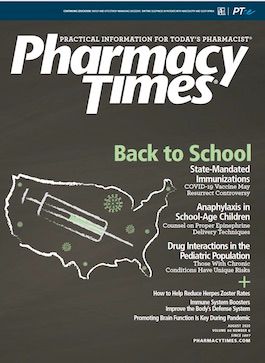Publication
Article
Pharmacy Times
Community Pharmacists Make a Difference With Immunizations
Author(s):
Despite some challenges, these programs increase rates and follow-up doses and improve patient communication.
There are many areas of patient care where pharmacists can have a direct impact, yet a number of them do not have the confidence or understand the potential magnitude of that impact.
If pharmacists want to continue to move the profession forward, seeking provider opportunities, they must gain that confidence and help stakeholders understand the important roles they play. These include conducting diabetes or point-of-care testing, but it is immunizations that provide the clearest snapshot.
Let’s go back to the years when pharmacists first saw immunization-friendly legislation being enacted from state to state. The National Association of Chain Drug Stores compared influenza vaccine rates1 from 2003 to 2013 to cover this period of pro-pharmacist legislation. During that time, 5.1 million vaccinations could be attributed to the new legislation. The American Pharmacists Association (APhA) Foundation also conducted a pilot study2 that looked at immunizations across 8 community pharmacies in Washington State. The study results showed that vaccine administration rates had increased by 41.4% over 6 months. In addition, for every influenza vaccine walk-in, 1.45 other vaccinations were identified as being due. Of those unmet patient immunization needs, 95% were administered by the pharmacist at the point of care. Understanding the impact pharmacists have had after receiving immunization privileges greatly boosts the case that they should be given additional responsibilities. After we shared these 2 studies with our federal and local representatives, they asked us about the local community we served. This led us to dive into our own initiatives.
We will start by laying out some important facts. Immunization is one of the most cost-effective means of preventing disease. Individuals can defend themselves against several diseases by staying up-to-date on all recommended immunizations. Additionally, as more individuals become protected from particular diseases, communities gain a collective immunity that aids in reducing complications, deaths, and hospitalizations. Community pharmacists can reach out to and educate patients in their communities, and administer these preventive immunizations to them.
Some challenges that providers face are consistent accessibility to the adult patient population, identifying patient vaccine eligibility, and supplying and administering all recommended immunizations in the office. Patient challenges range from access to reliable information, knowing which immunizations are recommended based on age or comorbidities, and remembering when to receive follow-up doses. By creating pharmacist-led immunization programs, community pharmacies can improve patient outreach, immunization rates, and follow-up doses.
From the most current data up to 2016, overall immunization rates for hepatitis A (23.7%), human papillomavirus (8.6%), influenza (70.4%), pneumococcal disease (66.9%), shingles (37.4%), and tetanus, diphtheria, and pertussis (26.6%) have increased slightly.3 Pharmacists have the optimal opportunity to increase these rates around the nation. Our pharmacy targeted 1 specific immunization in 2019, the shingles vaccine Shingrix.
In 2019, we promoted Shingrix immunizations on our Facebook page and flyers, and through individual discussions with the patients we identified as being eligible to receive them. The determination of eligibility stemmed from our Sync+ program, which analyzes patient profiles to determine chronic disease medication adherence, immunization eligibility, and preventive screening opportunities. Patients aged 50 years or older were identified as eligible for the Shingrix vaccination. Our Sync+ patients were sorted through alphabetizing by last name. This allowed for a staggered informing of eligibility versus a bombardment of vaccinations on a single day or week. When the program identified a patient as being eligible, we communicated a message through a written note in the patient’s Sync+ basket, as well as a typed note in the patient’s electronic profile. Pharmacy team members could then counsel patients at pick-up time about benefits, eligibility, and what to expect.
Because of the advertisements and 1-on-1 counseling, our pharmacy, Med-World, more than doubled its Shingrix vaccination rates in 7 months versus the rate in 2018. Of the 447 patients we have analyzed thus far through Sync+, 74% are eligible for Shingrix immunization, 26% of whom have received it. Numerous patients identified have yet to receive their 1-on-1 counseling, because of when their pharmacy system sync day falls during the month.
Many patients had questions about whether Shingrix is still given if they have already received the Zostavax immunization, and whether it is inactive or live. Patients who previously received Zostavax are still eligible, and we encourage them to receive the new shingles immunization. Although Zostavax is a live immunization and carries increased contraindications and precautions, Shingrix is an inactive immunization, which means greater availability to more people. Additionally, Shingrix is 97% effective at preventing shingles in people aged 50 years or older, whereas Zostavax is only 50% to 64% effective at preventing shingles in that age group.4,5
Once patients receive their first immunization, we document the date of their next follow-up dose on their comprehensive immunization spreadsheet and computerized profile note. Each month, a staff member calls patients within the 2- to 6-month period to inform them that it is time for the last dose of Shingrix. When patients have received both doses, the staff make the appropriate documentation. In 2019, our program completed 3.5 times as many follow-up doses versus 2018.
Based on our findings, community pharmacist immunization programs can have an extensive impact on immunization rates, especially regarding follow-up dose rates. Barriers to patient immunization initiation included the ability to contact patients, patients receiving the immunization at a different facility, and cost. Additional research and time are needed to determine the longterm impact that pharmacist-led programs have on immunization rates and follow-up doses. We plan to expand our immunization program to include other immunizations, such as hepatitis B, Pneumovax 23, and Prevnar 13B.
We hope that community pharmacists across the nation will gain confidence and better understand how to communicate their value to stakeholders.
If we can have this kind of impact on immunizations, what would the impact be across other point-of-care health services if pharmacists were entrusted with them?
Travis Wolff, PharmD, is the manager and co-owner of Med-World Pharmacy in Sapulpa, Oklahoma. Emma Leffler, PharmD, is a PGY1 community pharmacy resident at Med-World Pharmacy.
REFERENCES
- Drozd EM, Miller L, Johnsrud M. Impact of pharmacist immunization authority on seasonal influenza immunization rates across states. Clin Ther. 2017;39(8):1563-1580. e17. doi:10.1016/j.clinthera.2017.07.004
- Pilot project highlights pharmacists’ key role in identifying and resolving unmet vaccination needs. News release. American Pharmacists Association. Accessed July 24, 2020. https://www.aphafoundation.org/news-release-pilot-results
- Vaccination coverage among adults in the United States, National Health Interview Survey, 2016. Centers for Disease Control and Prevention (CDC). Updated February 8, 2018. Accessed July 24, 2020. https://www.cdc.gov/vaccines/imz-managers/coverage/ adultvaxview/pubs-resources/NHIS-2016.html
- Shingles vaccination. CDC. Updated January 25, 2018. Accessed July 24, 2020. https://www.cdc.gov/vaccines/vpd/shingles/public/shingrix/index.html
- What everyone should know about Zostavax. CDC. Updated January 25, 2018. Accessed July 24, 2020. https://www.cdc.gov/vaccines/vpd/shingles/public/zostavax/







